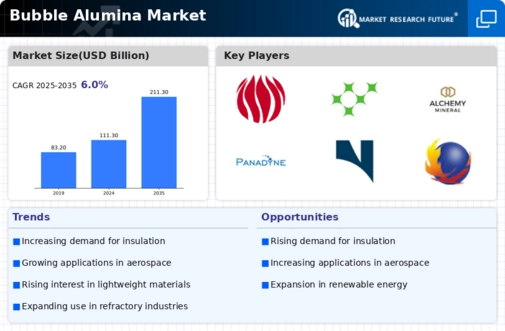Market Share
Bubble Alumina Market Share Analysis
In the Bubble Alumina market, companies employ various market share positioning strategies to gain a competitive advantage and expand their market presence. One primary strategy is differentiation, where companies highlight unique features or benefits of their bubble alumina products compared to competitors. This could include aspects such as purity, particle size distribution, thermal insulation properties, or specific applications like refractories, ceramics, or insulation materials. By emphasizing these distinctive qualities, companies aim to attract customers who value these attributes and are more inclined to choose their products over alternatives available in the market.
Cost leadership is another significant positioning strategy in the Bubble Alumina market. Companies often strive to offer their products at competitive prices while maintaining quality standards. This approach appeals to cost-conscious customers and can help companies capture market share by providing cost-effective solutions compared to competitors. Additionally, companies may invest in efficient manufacturing processes or sourcing strategies to further reduce costs and enhance their competitiveness in terms of pricing.
Niche targeting is also prevalent in the Bubble Alumina market. Instead of targeting the broader market, companies may focus on specific segments or applications where their products can address unique needs or requirements. For example, a company might specialize in providing high-purity bubble alumina for use in the production of advanced ceramics or as insulation material in high-temperature industrial processes. By catering to niche markets, companies can often command higher prices and build stronger relationships with customers who value specialized products and expertise.
Market segmentation plays a crucial role in positioning strategies for the Bubble Alumina market. Companies may segment the market based on factors such as industry verticals, geographical regions, or end-user applications to better understand and target their customer base. By tailoring marketing efforts and product offerings to specific segments, companies can more effectively address the diverse needs and preferences of their target audience, thereby increasing their market share within those segments.
Branding and marketing efforts are essential components of market share positioning strategies in the Bubble Alumina market. Strong branding helps companies differentiate their products from competitors and build trust and recognition among customers. Effective marketing campaigns, both online and offline, can further reinforce this positioning by highlighting the unique benefits and value propositions of the company's bubble alumina products. By investing in branding and marketing initiatives, companies can increase awareness, generate demand, and ultimately capture a larger share of the market.
Partnerships and collaborations are another avenue for market share positioning in the Bubble Alumina market. By forming strategic alliances with suppliers, distributors, or industry partners, companies can expand their reach and access new markets or customer segments. Collaborations can also provide opportunities for knowledge sharing, research, and product development, enabling companies to innovate and differentiate their offerings in the market.
Innovation is a critical driver of market share positioning strategies in the Bubble Alumina market. Companies that invest in research and development to develop new formulations, applications, or manufacturing techniques can gain a competitive edge by offering innovative solutions that address evolving customer needs. Whether it's developing bubble alumina with improved strength, thermal stability, or chemical resistance, innovation enables companies to stay ahead of the competition and capture market share in this dynamic industry.











Leave a Comment